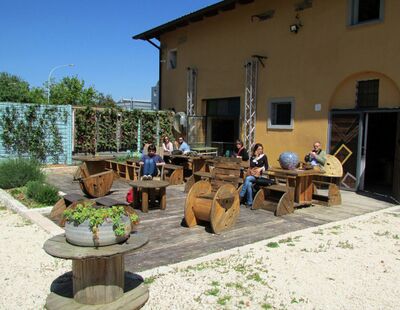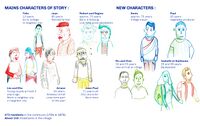LED2LEAP 2020 - Bologna Team 2: Difference between revisions
No edit summary |
|||
| Line 125: | Line 125: | ||
= Phase B: Democratic Landscape Analysis and Assessment = | = Phase B: Democratic Landscape Analysis and Assessment = | ||
''* | == The Scene in your Story of Analysis == | ||
*''Describe your landscape democracy challenge. What is the physical scene, specific description of the landscape? What are the socio-economic and political characteristics of place? Are there any important contextual elements?'' | |||
*''add the corresponding visual from your presentation to the image gallery below'' | |||
<gallery caption=" " widths="200px" heights="150px" perrow="5"> | |||
File:yourcase_scene1.jpg|''add a caption'' | |||
</gallery> | |||
== The Actors in your Story of Analysis == | |||
*''Describe the characters and their role in the story. Are they major or minor characters? Are there any key relationships that need to be defined?'' | |||
*''add the corresponding visual from your presentation to the image gallery below'' | |||
<gallery caption=" " widths="200px" heights="150px" perrow="5"> | |||
File:yourcase_actors1.jpg|''add a caption'' | |||
</gallery> | |||
== The Story of Analysis == | |||
*''Describe the plot of the story and how it plays out.'' | |||
*''add the corresponding visual from your presentation to the image gallery below'' | |||
*''add as many additional images as you like'' | |||
<gallery caption=" " widths="200px" heights="150px" perrow="4"> | |||
File:yourcase_story1.jpg|''add a caption'' | |||
File:yourcase_story2.jpg|''add a caption'' | |||
File:yourcase_story3.jpg|''add a caption'' | |||
</gallery> | |||
== Reflect on your Story of Analysis == | |||
*''How did the tools you chose for landscape analysis fit your community? Reflect on the questions: What did you carry? Why did you carry? How did you carry? What remains after you've left? (150 words)'' | |||
*''add the corresponding visual from your presentation to the image gallery below'' | |||
<gallery caption=" " widths="200px" heights="150px" perrow="5"> | |||
File:yourcase_refelction1.jpg|''add a caption'' | |||
</gallery> | |||
= Phase C: Collaborative Visioning and Goal Setting = | = Phase C: Collaborative Visioning and Goal Setting = | ||
Revision as of 13:26, 5 May 2020
>>>back to working groups overview
Landscape Democracy Rationale
- Why do you think this community context is relevant from a landscape democracy perspective? What is your hypothesis considering the landscape democracy challenges?
- Format: 3-4 sentences
Location and scope
Phase A: Mapping your Community
Places
There are two locations, one in the Villaggio del Fanciullo, in Scipione del Ferro street, near the railway station the other is called Spazio Battirame. The Villaggio del Fanciullo is called in this way because different social realities live there, a kind of smart village built in the 20s that from a convent has become a place where different social realities and other cooperatives meet. In this once-religious space different legal entities share the location and have a common background. There was an initial division between the people that were sent to share a space and had apparently nothing in common. But through out time, a symbiotic mechanism is activated, allowing the actors to cooperate and live together in the shared space. Instead Spazio Battirame initially was a colonic house from the nineteenth century, owned (ound) by one of the most important family in Bologna at the time. A strip of land is still connected to this space, revealing the Roman geometric scanning of the fields still present today. This colonic house still has a stable and a barn; in the 70s it was abandoned and lost its historic value. In the 90s a social center was moved in the area; more over, a tensile structure, initially built for Italia 90 Worldcup was reused there and divided into two parts. The association that stayed there, Livello 57, usually was a source of public disorder, organizing concerts and various events. At the end of 2007 there was a gas explosion causing victims; and for this reason everything was closed. The place, left to itself, became a place of abusive activities, until the arrival of Eta Beta In 2014; their presence lead to the transformation of this land from the industrial area of Bologna into an agricultural area, with teaching rooms and a restaurant that opened soon after their presence began to be noticed.
Socio-economic characteristics
The cooperative is a mixed type cooperative, being at the same time type A and type B. These cooperatives in general have a difference in their balance sheets and financial reports and in how they are viewed by the central government. The type B cooperative mainly deals with production work with disadvantaged groups that can be various, but in particular it deals with the sector of psychiatry, addictions and social problems.
The community is thought as an enclosed circle that three pillars sustain:
- The man, intended both as citizen and as monk, in the greek meaning of the word, “monakos”, that stands for a lonely part in his relationship to the others;
- Wellness and community, as individual well-being, and as collective community health;
- Creativity, because the well-being in a community is made possible by making unique things with benefits on the community itself.
Groups of actors and stakeholders in your community
The cooperative works with the following disadvantaged groups:
- people with addictions;
- people with psychiatric needs;
- unaccompained minor;
- Prisoners;
- Foreigners;
- Refugees.
The various branches of Etabeta Cooperative exist thanks to the collaboration with some external agencies you can see on the diagram picture. The most important one is the AUSL in Bologna. Usually type-A workers are tutors for the activities the type-B workers do.
Spazio Battirame Activities ad Places
- Tensile strcuture and workshop:
- Glassmaker workshop;
- Ceramic workshop;
- Woodworking workshop.
- Orchards and gardens:
- Different kind of terrains with various functions;
- Inside courtyards;
- Orchards;
- Cycle-garden corridory.
- House and cooking:
- Kitchen;
- Cafè;
- Barn;
- Cooking school.
Relationships between your actors and groups
This is a short list of the cooperative activies, they all follow the ideals of the cooperative: social functions, well-being, sustainability and education and collective culture.
- Laundry: born in 2009, a service of washing and rental of diapers dedicated to private and public kindergardens in Bologna. This activity was never done before in Italy and its impact is remarkable.
- EtabetaBio: agriculture activity born since 2019, autonomous thanks to the four hectares of terrain given in concession to the cooperative from S. Donato and S. Vitale districts.
- Alfa-Beta: activity of cleaning in external places and specific things, like ambulances, condos, ambulatories.
- Workshops: glassmaker, ceramic, mosaic and woodworking workshops made for socio-rehab purposes in the tensile structure of spazio Battirame.
- Seminars, meetings, traning courses of various kind.
- Post-school activities in Villagio del fanciullo.
The different branches of the cooperatives are not independent but they collaborate one with another. In Spazio Battirame they achive to create a fertile dialogue between them: the raw materials of the kitchen comes from the orchards nearby, and it’s served during the activities for the cooking schools. Part of the vegetables is sold in the Novale market to the local population. The workshops make the dishes used in the kitchens and they also distribute them to high-level restaurants thanks to the partnership with the local company “Servito”.
Summary of your learnings from the transnational discussion panel on April 22
The main difference between Bologna case study and the others is mainly the scale of the location. While Eta Beta's community works within the spacial range of a neighborhood, the other group were given a location much more bigger. This of course change the methods of research needed to explore such communities, that we have shared in the presentation
Reflection
Our locations are a great example of how pre – existing physical space can take on different connotations during its life based on usuale habits of the visitors , while remaining the same space. The locations are in fact witnesses of how the passing of time, coupled with the change of the populations inhabiting the space can shape the landscape itself, proving the human nature of this element (the landscape). There are not negative or positive spaces, they are all neutral. The community and the actions they made are indeed the ones which define whether the space is good or bad.
Problems
As designer we should investigate which kind o society we are building next. Nowadays however the necessary discussion to study the landescape, a human perception, is particulary difficult. We hope we can still tackle wicked problem even with the limited mens we have in isolation. As It’s no secret that seeing things with your own eyes results in better perceptions, but for this time, better be safe and stay at home.
References
- give a full list of the references you have used for this section
Phase B: Democratic Landscape Analysis and Assessment
The Scene in your Story of Analysis
- Describe your landscape democracy challenge. What is the physical scene, specific description of the landscape? What are the socio-economic and political characteristics of place? Are there any important contextual elements?
- add the corresponding visual from your presentation to the image gallery below
- Yourcase scene1.jpg
add a caption
The Actors in your Story of Analysis
- Describe the characters and their role in the story. Are they major or minor characters? Are there any key relationships that need to be defined?
- add the corresponding visual from your presentation to the image gallery below
The Story of Analysis
- Describe the plot of the story and how it plays out.
- add the corresponding visual from your presentation to the image gallery below
- add as many additional images as you like
- Yourcase story2.jpg
add a caption
Reflect on your Story of Analysis
- How did the tools you chose for landscape analysis fit your community? Reflect on the questions: What did you carry? Why did you carry? How did you carry? What remains after you've left? (150 words)
- add the corresponding visual from your presentation to the image gallery below
- Yourcase refelction1.jpg
add a caption
Phase C: Collaborative Visioning and Goal Setting
* template coming
Phase D: Collaborative Design, Transformation and Planning
* template coming
Phase E: Collaborative Design, Transformation and Planning
* template coming
Phase E: Collaborative Evaluation and Future Agendas
* template coming
Process Reflection
- Reflect in your intercultural and interdisciplinary team on the outcomes of your study
- Which limitations were you facing?
- What have you learnt from each other?
- What would you do differently next time?
- You can also use diagrams/visuals
- 250 words text









